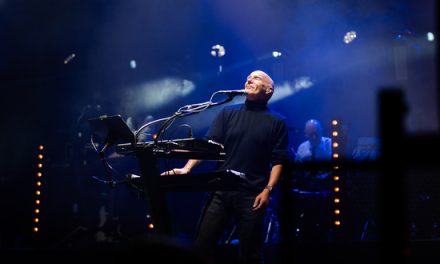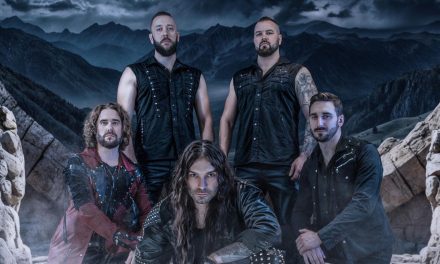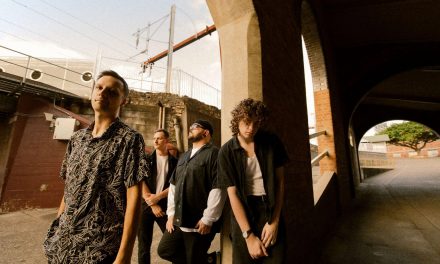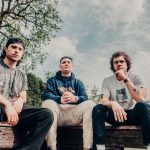
Meat Beat Manifesto: The Man Behind the Curtain
 Meat Beat Manifesto: The Man Behind the Curtain
Meat Beat Manifesto: The Man Behind the Curtain
Jack Dangers began making music in the 1980’s and while in instrumental group Perennial Divide he began recording music as Meat Beat Manifesto, experimenting with hip-hop, noise, jazz, industrial, techno, funk, reggae and more. Inspired by Public Enemy‘s production team The Bomb Squad, Dangers took off on his own unique path. As Meat Beat Manifesto (MBM) Dangers’ music has appeared in The Matrix movie, and has inspired many to make music that defies genre boundaries. Impossible Star, MBM’s 11th studio album and their first in seven years, shows Dangers in a playful yet thoughtful mood, a synthesis of the music he’s been making since 1986. With visual artist and electronic musician Ben Stokes as his creative foil, Dangers will take his multi-media show on the road in 2018. The day after Thanksgiving I spoke with Dangers from his home in Northern California about vinyl, his rebuilt house, the new album and his legacy in outsider music.
It’s been seven years since we heard new music but I know you’ve been kept busy. You rebuilt your house?
Ya, its thrown a big spanner in the works. We had to leave the place we’ve been in since 1993. We rebuilt the whole thing and I was in another studio space for a couple of years. I was working on stuff there but I ended up redoing it all when I got back into my new place just because I was used to the sound there after working in the same environment after twenty years. Everything is back to usual now. I’ve been doing other things in that time, other projects. So now it’s time for the new album and doing live shows. We actually just played in L.A. just a few weeks ago. [Cold Waves L.A.]
How was the show?
It was great. A really enjoyable show. We had an hour set which is probably a good thing. The shows we did last year were two hours long and people still wanted more and I think its a really good thing, leaving people wanting more. The hour set was a good combination of tracks from our last 30 years and it seemed to go down really well. We did a track off the new record, did some things from the first one, all the way through. An enjoyable experience all the way around.
Will you be bringing with you on tour a new, updated multi-media show circus this next tour?
We’ve always had the heavy visual component whether it was working with real, human, three-dimensional dancers or just using visuals on screens. We still do a lot of live video sampling and stuff like that. So, ya, definitely multi-media. We have eight computers. We have to set that all up, it takes a couple of hours to set everything up. I’ve got the mixer, I’m doing vocals, I’m doing a lot of vocoder and a alot of video sampling so I’ve got my hands full. We’re sandwiched in between: we have the screen in front of us, a mosquito net so you can sort of see us through it, but its primarily images, then we’ve got a back screen so its all sandwiched in the middle. If we had a normal screen in front, we’d be a bit too lost.
I’m coming up with some ideas for next year’s shows were you’ll be able to see what’s going on onstage a little more. I’m working on that, maybe live body cameras. We sort of did that in the past, where I would do a vocal there’d be a lipstick camera, these little cylindrical cameras which would be on a stand. But now we have all these new types of body-cams, you can wear on your ear, or on your head. I’m going to look around some other things and see what we can come up with.
That should be really interesting.
Ya, even in a video feedback way, you can do interesting things just by looking at each other. Get it back out next year probably April or May. The album is still scheduled to come out in January.

So have you only heard a few tracks?
I’ve heard the whole album, bought the vinyl and the flexidisc. I’ve been seeing you live since before you started adding the visuals in your set. Now we can see the footage you took all those audio samples from.
Did you ever see the early shows where we had dancers?
I don’t think I started following you that early on.
We did that between ’87 and ’91.
Now I’m going I’m going onto Youtube to find footage of you with dancers onstage.
There’s some up there. It was a different kettle of fish altogether, visually. Still interesting, different at the time. We had all these different costumes and stuff. Not so much me. What I liked about it was that it kept everybody busy looking at what they were doing rather than at what I was doing. So we perfected that sort of hiding behind things, especially with what we’re doing now. I’ve always liked to keep out of the way rather than get out in front of the stage and put my foot up on the wedge. Rock’n’roll style.
I think I just got the title for the interview, the Wizard of Oz, the man behind the scenes.
Exactly, behind the curtain.
I’ve seen Sigur Ros and they put up a curtain in front of the stage, Roger Waters and Pink Floyd, building a wall in front of the band. Maybe you guys will peek out from behind the curtain every once in a while.
I remember we did a show with Autechre in London back in the ’90’s and there was no room onstage so they just set up in the dressing room and did their set from the dressing room. So I thought that was pretty cool (laughs).
Did anyone in the audience know the duo weren’t there?
Well, people knew they were playing but they couldn’t see them. They knew they were somewhere in the building. They’re very low-key. We did a show with them in Oakland back in 2000-2001 and they did the same thing. They didn’t have any lights, all the lights were turned off and they were just sitting down on the floor. I’ve always liked that approach, just being out of the way, so you can just enjoy the music and the visuals.
I was looking up your partner Ben Stokes online and he did the visual backdrop for DJ Shadow. That would have been too much stimulation for me, I would be in the back with my eyes closed, just listening to the music. But it was interesting to think that live, you really don’t need a lighting setup so much anymore, you can just have screens or projections.
He’s been doing that for a while. He did those shows and Brainfreeze. Since I introduced them back in the ’90’s. Ben has always made videos for different groups. Now he’s working for a company which projects three-dimensional images on buildings.
I did all the visuals for this tour. I made videos for all the songs. I did a video for Lurker, which is on the new album. I did that a couple of years ago, it was another version of it which came out on Skam Records in the UK. I did a video for that. It’s on Youtube. And then I did a couple of new versions of it and more or less sandwiched it all into one big song on the album called Lurker.
I didn’t realize it was that long, I thought it was two or three songs.
It might be three, there are three sort of segments you can hear them going into the different tracks. I’ve done that all through the years sandwiched different versions, like Parts 1-3. I did that on Storm the Studio…, I’m continuing with that idea on the new album. It’s edited down from several hours of material, that whole track is. It might end up ten or twelve minutes but the original source material is over a couple of hours.
When we were talking about Subliminal Sandwich and how you did the same thing, you had hours of music and you pared it down to the best bits.
People have done that alot, they’ve used that form of subterfuge in music and in films over the last hundred years. It’s all a big trick. It’d be boring if you had to listen to six hours of jamming. It’s like painting, It’s just finding the best bits and narrowing them down.
Boards of Canada work like that as well. They have tons of material and it’s like whittling down the best parts.
You also did Variaciones Espectrales where you made seven tracks in seven days.
Ya, that was the opposite. I had to work really fast. I started in the morning and finished in the evening. In the old days, the way you’d record an album you’d go in the studio and do the whole bloody thing in a day. It’s all about playing live.
You couldn’t do that, could you?
No with this music. I like working in a more protracted way. You can spend too long on a track and end up going in circles.
Which track on the new album did you take the longest on or the shortest amount of time?
The longest one would be Synthesizer Teste or the middle section of Lurker. Probably the middle section, part 2 of Lurker. I spend a couple of weeks on that, many hours of material to go through on that one. Where the quickest would have been Rejector, which was a live recording. That was all done in real time.
Do we hear live bass on the album?
Oh yes, I played bass on Bass Playa, surprisingly enough. I played some other bass instruments on there as well. I played bass flute and bass clarinet. But they’re treated in such a way that you wouldn’t really know that’s what they were. I played them on We Are Surrounded as well, I played bass flute on that. That was my first instrument that I picked up and could actually play, the bass guitar. I’m still using the same one I’ve used on everything I’ve ever done. Like the bass line on Radio Babylon.

One of my nephews plays bass clarinet and I was wondering if there was anything to practice off of.
Obviously, anything Bennie Maupin‘s on. The Headhunters, the Herbie Hancock stuff, Eric Dolphy , he’d be the first obvious choice to check out. That would be my main ones.
The jazz musicians?
That’s the way I heard the instrument for the first time. Well, they were already being used in orchestras and theme music and Bernard Herrmann. But as a solo instrument, I might be wrong on this, but I think that Eric Dolphy was the first one to popularize it as a solo jazz instrument.
You use audio clips in your music from movies. I think you said you’d record them from the TV onto cassette or VHS?
It would always be on VHS if it was on TV, or films. I would sometimes use Dictaphone and just like you’re recording this now, I would hold the Dictaphone up to the TV speaker.
It seems to me that you and Ben Stokes are like brothers because you two have some shared interests, kitschy sounds from the 50’s and 60’s, jazz…
Oh ya.
I was watching his directors reel and a video for his song Quiet World of his great uncle at summer camp in 1945 playing around.
He found all these reel-to-reel tapes from that time period as well and brought them over here, ran them through a couple of machines. I got to see some footage of him growing up. I never really had any equipment to do that with when I was a kid. I missed out on that one.
I think that’s why you said you picked up the bass guitar.
I had that sense of rhythm and I couldn’t afford any drums or anything too noisy where I lived. I bought a bass on a loan payment scheme from this music store and I practiced to Sly and Robbie. They were my tutors. I played Grace Jones records and King Tubby records and learned how to play bass that way. All of them one finger, one string bass lines. More of a dubby bass line, those are the bass lines I like.
Your style is kind of sparse.
Both of us have always liked the easy listening music. It’s always like this eerie, subversive undertone like impending doom. Like the scenes in One Flew Over the Cuckoo’s Nest, where the easiest of music is playing in the background while they’re getting their medication. It’s that sort of angle. I think Throbbing Gristle went down that road with 20 Jazz Funk Greats on the cover making it look like something it wasn’t. I’ve always liked that subversive artform.
You do have a lot of things going on in your music, sometimes in the background that I didn’t notice on first listen of Impossible Star. You do craft your music in a very interesting way.
A lot of vocals on there as well which you wouldn’t necessarily know were vocals. I’m treating them with vocoders and stuff. Or I’m just doing harmonies, that’s more prevalent on this record than any other thing I’ve ever done. Each album has gone in a different way. There’s always that dub element to it from the first album there’s some reggae-influenced stuff on Storm the Studio. So when dubstep came along I was already into stuff like Scorn. Which he (Mick Harris) was doing before anyone came up with the term dubstep. Even elements of that cross over into Autoimmune and Answers Come In Dreams even a little bit on this record.
Some say you’re the father of dubstep.
I don’t think so. I would say Scorn, Mick Harris, the drummer from Napalm Death, he was doing stuff like that way before anyone even came up with the term. It’s basically half-time drum and bass anyway. it’s like drum and bass with the fast bits taken out.
I just think of it as dub.
It all goes back to King Tubby in Jamaica. It’s Jamaican electronic music.
I saw a documentary on dub and they were saying that they were on an island, with limited equipment, a few studios and a few musicians so they learned to make the most from what was played and recorded. The studio became an instrument.
Growing up in the UK in the 70’s, Jamaica used to be under British rule and got their independence in the 60’s, there was a whole immigration plan so a lot of Jamaicans moved over in the 60’s and their music seeped through into the charts in the 70’s. That’s something I was inspired by. Over here (in the States) not so much. That was your blues and soul music.
That’s what Reggae is based on, their version of American Blues. But it comes out completely different. Growing up in Britain there was always something on the charts, whether it was Althea & Donna‘s Uptown Top Ranking which got up to number 1 or The Liquidator, there was always something on the charts there. Over here, it was all Soul or Funk or Disco.
We had Bob Marley.
Well, Bob Marley was the Bob Dylan of Reggae. He was popular and famous everywhere.
Will you be doing any remixes for this album or will you be remixing others’ music?
I did a remix of Clock DVA and a remix of Gary Numan for his last single. I’m going to do a remix of Synthesizer Teste and We Are Surrounded for 12″ which will be out after the album is out. probably do a video for it as well. We incorporate that into the live show.
I was reading an article with you and Gary Numan and you said that in preparation for the remixes that you listened to his earlier work and it was very forward thinking.
I was 14 when he was on Top of the Pops and XTC as well doing Making Plans for Nigel so growing up with that kind of music is going rub off on you in some way whether you acknowledge it or not. I’ve always like Down in the Park an early track, when he was in Tubeway Army, a very good version of it on a John Peel session. You had to do those in a studio, but you had to play it live. Sounds just as good as when it came out on the album. And he’s still going, playing big venues, still getting people out. Pretty rare.
I’m a big John Foxx fanatic as well i like the Metamatic album. He was a big influence on me when that record came out, very cold, alienesque synthscapes with a CR-78 Roland drum machine.
Do you know that album Metamatic?
No, I don’t.
If you like Gary Numan you’ll like that one. They always were going off one another. John Foxx used to be the singer for Ultravox and Brian Eno produced them back in ’78, they were a punky version of what Gary Numan was doing. That’s the obvious Kraftwerk influence which was big in Britain. Bands like Human League and Orchestral Maneuvers in the Dark.
That cold synthesizer sound.
John Foxx was the coldest of them all. You should check his stuff out. He really inspired me. He’s still going, still doing shows.
Seeing that article from Dwell Magazine about your house I also saw pictures of a lot of records. We talked before about your record collection and now I see it. Your house is nice and clean, with a lot of wood. I read that your one synthesizer deck they basically had to make a way to get it in. So they built the house around the synthesizer?
We had to, when the day came where we had to move the EMS Synthi 100 we had to get a piano mover company of six people who came. They do that all the time, they move mixing desks, which are way heavier than this. So it’s nothing to them. So a contractor came in and actually made a huge square in the wall, just cut through everything. It only took them ten minutes but I was like wow, that’s pretty quick. Anyone could have done that during the last 20 years. it would have made a lot of noise at 3am in the morning, but they made a great big square in the wall and it went up this big hill and it went into storage for a couple of years during which time there was an earthquake in the same radius where our stuff was sitting in storage. That was scary. I went down there to see if it was upright and not on the floor.
That’s your baby.
Remember the Napa earthquake in 2014? Everything was there: the records, everything. I had to go down and make sure everything was there and OK. We got everything back in and about three years later I’m still trying to find certain records. I was having trouble last week digging out these Christmas records and I finally found them. I’m still moving my stuff back. Like I said, a big spanner in the works. Otherwise, this album would have come out years ago. But then again, it would have been different because tracks like TMI, I only did that about a year ago. Lyrically you can tell it’s recent too. Still trying to get everything back in order.
What is the most recent album you’ve bought and why did you get it?
Oh, good question, let me see. Well, I’m looking at it right now. It was two 12”’s actually. It was Whodini‘s Magic’s Wand. do you know that song?
No.
Early Rap-Electro song. It’s the first thing Thomas Dolby ever produced, back in ’82. It’s really good. It says on the front “22 minutes of music” on a 12″ so it’s an extended version there which goes on and on. And the other 12″ I got was Murphy’s Law by Cheri which is a song I’ve always liked. That’s an old habit I have of picking up old 12″ extended Disco mixes. I got all these records off of Discogs, a compilation called Experiment 1950/60 – Elektronische Musik featuring all the classic originators of Electronic music from the classical side like Berio and Maderna and Xenakis, people like that.
So you still have passion for music and finding things like that. It’s also nice to have a few dollars to buy them.
They’re usually pretty cheap, the 12″‘s, when you’re looking for those, a couple of dollars. And the other one was like ten bucks. But I cannot stop buying records. I’ve been buying records since 1979, nonstop. I just sold 3,000 to Josh, DJ Shadow, that I didn’t want anymore. I didn’t have room for those, they were in the garage. They just kept getting in the way and he came over and looked through my old boxes and took the whole lot.
That will be his next Brainfreeze show: The Jack Dangers Collection.
He has done one song from elements of a couple of records, being re-purposed for future music fans.
Do you buy the music for personal pleasure or sound sources or a bit of both?
It started off absolutely personal, like the first album I ever bought was Trans-Europe Express by Kraftwerk. I was a couple of years late back in ’79, it came out in ’76. Then I went back and listened to all the other stuff. I was finding records like Trout Mask Replica, you know, just pure pieces of genius art. Just in a music form. No one gets the same type of credit as like what art does. Even Classical music. Andy Warhol would be way more famous than anyone in the music sphere.
When I got into making music and sampling things, that was another thing. I’d buy records for a drum break on that one. And then getting into the music itself and just listening to Public Enemy and Beastie Boys and finding out where those samples are from.
It was J Dilla, we were playing a record last night at a friend’s house we went around for a vegetarian Thanksgiving and Mark Pistel, he heard a 10CC sample and he was chuffed that he recognized the sample. So that amount of surprise is still there, even in sampled music. So it is interesting to find out where it first came from.
I’m looking forward to getting the vinyl, the flexi-disc. I appreciate the talk, I’m looking forward to the live show sometime in 2018. It better be a big enough venue to fit all your screens and gear.
We always manage somehow in the end.
If not, it might be just the computers and screens and you and Ben up in the dressing room.
We’ll do all the shows from now on in the dressing room and just play films.
(Impossible Star is out January 19th on CD, digital download and vinyl.)
(Interview by Bret Miller)
LINKS:










 Meat Beat Manifesto: The Man Behind the Curtain
Meat Beat Manifesto: The Man Behind the Curtain






